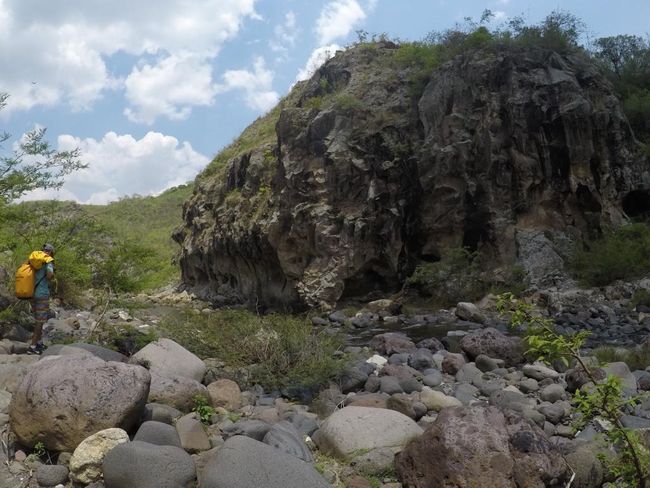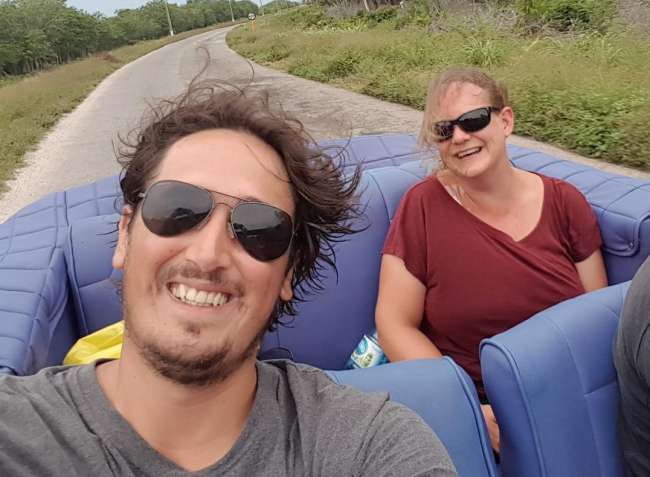Nicaragua: Esteli & Somoto
Publikovaný: 23.05.2018

































Odoberať novinky
We returned from Managua back to Leon and from there to Esteli. Unfortunately, due to misinformation at the bus terminal in Leon, we missed the direct minibus and ended up taking a long and arduous journey on the chicken bus. And as if that wasn't enough, the bus assistant promptly ripped us off and we paid a fortune for the damn bus ride (Editor's note: although this "fortune" was only about $4, it was twice as much as the fare should normally cost). Unfortunately, we realized this too late amidst all the running for the bus, loading luggage onto the roof, and searching for a seat. When we complained to the assistant, he generously gave us back about 30 cents. Very nice, thank you. Well, even as an experienced traveler, you're not always immune to being tricked every now and then, you just can't take it personally. I see it like this: if the guy feels the need to cheat us out of $1.70 and we're too stupid to notice, then so be it.
After a long and exhausting journey, we finally arrived in Esteli and grabbed a taxi to the hostel. Taxis in Nicaragua work differently than in any other country we've been to. Here, a taxi is always considered a "collective," unless you explicitly insist on a "private" taxi. This means that the negotiated fare always applies per person, and the taxi driver can stop and pick up additional passengers at will. He then drops them off one by one at their desired locations. If you want a private taxi just for yourself, you have to say so, and you usually pay the price for all 4 seats. This can lead to some misunderstandings if you don't know that. On relevant travel advice websites (e.g. EDA), it always says that for safety reasons, you should never allow other people to ride in the taxi. The first time we were quite surprised when the taxi driver suddenly stopped on the street to let more people get in. We handled it by allowing the collective rides during the day, especially since it was always only women and children with whom we shared the vehicle. But after dark, we insisted on private taxis and paid the corresponding surcharge. After all, personal safety is not a place to save money.
Esteli is known for its cigar factories, and indeed the whole city is full of them. There are countless cigar factories, large and small, and the majority of the population seems to be working in this industry. However, we decided not to visit another factory here. After all, we had already had the privilege of visiting 2 factories with private tours in Danli, and that would hardly be surpassed by the tourist program offered here.
Instead, we decided to book a canyoning tour in the Somoto Gorge. This is where the Rio Coco, the longest river in Central America, is formed by the confluence of two other rivers. The river has carved a 3km long gorge into the hard granite rock in the Somoto region, which is about 200m deep and sometimes only about 10m wide. The canyon was "discovered" by two Czechs in 2004. Of course, the locals already knew about the existence of the gorge, but it was only developed for tourism from that point on. Since then, much has changed, especially in terms of safety. For example, in the early days, the guides didn't even offer life jackets, but nowadays it's standard. Each guide is also equipped with a dry bag to transport the participants' belongings and cameras. Previously, they would have simply carried the valuables in a plastic bag on their heads through the water, we're told. We booked our tour via email with the company of the same name, "Somoto Canyon Tours". The goal is clearly to benefit the locals from the gorge's revenues, employing people from the region as guides and boatmen, and local women cook meals for the guests. Some rooms for overnight stays are also available.
We had to organize our own transportation to Somoto, i.e. we had to catch the bus in Esteli at 7:30am. The journey took about 2 hours. At the bus terminal in Somoto, our guide Rigoberto was already waiting for us. We were driven to the entrance of the gorge in a pickup truck. There, we could rent old sports shoes so that we didn't ruin our own shoes in the canyon. Unexpectedly, they even had shoes in Jörg's size! And then it started, the approximately 5-hour tour. We crossed the canyon by hiking and swimming. Along the way, we saw caves, various birds, and bats. Rigoberto also had a lot of information about local plants and their medicinal properties, and he could also warn us about a very dangerous plant that should not be touched, as it can cause huge ulcers and pain all over the body. That was really interesting.
Currently, it was dry season, so there was more hiking than swimming. It quickly became clear that the tour is probably completely different depending on the season you visit. During the rainy season, it's also much more dangerous, with higher water levels, stronger currents, whirlpools, etc.
The opportunity for cliff jumping is very popular on the tour. The highest possible jump is about 22m. However, Jörg and I didn't feel like doing that, we only jumped into the water from about 2m, which was already enough adrenaline for me. Rigoberto jumped twice from about 20m, but that didn't really motivate us to do the same, it was more fun to just watch him from below.
We didn't come here for cliff jumping, but for the scenery, and it was absolutely worth it. The gorge is truly breathtakingly beautiful and the visit is an amazing experience. It was great fun drifting through the cool water and hiking along the steep rock walls. In fact, it was quite tiring, as it required a lot of concentration to walk on the rocky and slippery ground for so long.
It was also cool that we were the only participants on the tour and had our guide Rigoberto all to ourselves. This allowed us to have many interesting conversations and practice our Spanish (which was a challenge considering the speed at which Rigoberto spoke. Latin Americans generally have the habit that as soon as they notice that you speak Spanish somewhat, they no longer take any consideration and let their tongues loose like a machine gun). It also had the advantage that Rigoberto could act as our personal photographer. At every beautiful spot, he quickly opened his backpack, took out the camera, and asked if he should take a photo of us here. Funny enough, he also had the habit of constantly stepping into or swimming into our photos that we actually wanted to take of the gorge.
In fact, we were not only the only tourists on the tour, but also the only tourists in the canyon at all. We didn't encounter anyone else, no other groups. Rigoberto said there was only one other group today, and they had left earlier than us. He explained that this was related to the demonstrations and protests in Nicaragua, there had already been over 20 cancellations for this month. He said it was such a shame, he couldn't understand why people take to the streets and destroy everything that has been built since the civil war. He wants peace in Nicaragua, without peace, there would be no more tourists.
In fact, almost everyone we spoke to was against the demonstrations, but these people were almost all those who have dealings with tourists. And experience has shown that these are also the better-off ones, those who directly receive money from tourists. But what about the others? Of course, it's terrible for a country if tourism, one of its most important sources of income (hopefully only temporarily), disappears due to such a conflict. But is it worth accepting major problems in the country that affect a large part of the (poor) population, without fighting against them? Does it make sense that many people suffer for the benefit of a few? Of course, you can argue indirectly that everyone benefits from additional income in the state budget through tourism, from more money flowing into the country. And the illuminated metal trees can also contribute to promoting tourism and thus "general prosperity". But try explaining that to a poor farmer who struggles day to day to support his family. Or to a pensioner who has worked hard all his life, possibly even a veteran of the civil war, and whose already meager pension is being cut by 5%.
Some conflicts probably just have to be fought out in order to have a chance of improvement, and outsiders should not get involved in my opinion. The affected people should be able to settle it among themselves.
So, enough of political discourse for now, back to our adventure: Towards the end of the tour, we were taken a short distance by rowboat to the exit of the gorge. From there, we walked back to the office of "Somoto Canyon Tours". There we had a small late lunch before taking the bus back to Esteli.
It was a very successful excursion, although the thrill was somewhat limited. During the rainy season, this is certainly a completely different experience. However, you can't see the caves and animals at that time. Oh yes, I forgot to mention the huge spiders that were lurking everywhere on the rock walls and can even crawl over water. I could really have done without those creatures!
In any case, the landscape is the main reason to come here, it's truly enchanting and "vale la pena," as the Latinos say (worth the pain). But see for yourself in the photos.....
Odoberať novinky
Odpoveď

Cestovné prehľady Nikaragua

